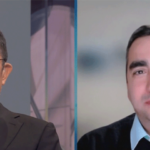An interview with Chinese contemporary master artist Wenda Gu
Chinese contemporary master artist Wenda Gu speaks to KraneShares and Annie Zhou, Executive Director of Harmonia Holdings, Ltd. about his experiences as an artist in the US and China.
As one of the pioneers of the Chinese contemporary art movement, Mr. Gu’s humble demeanor and global outlook make him one of the most significant and forward-thinking international artists.
These excerpts from his interview provide a window into his world.
Tell us about your experiences in the US vs. China
It is very challenging and difficult to survive as a contemporary artist, but I’ve been in the US for 26 years now and have never worked a single day in another job. It’s true that I guess I have realized my American dream. Now that I’ve also established my studio in China, I am realizing my China dream and sharing my art with both cultures
What are some of the trends in the Chinese contemporary art market?
If you talk about the market place, art has become a commodity. Therefore it eventually has to be consumed. The art market has evolved tremendously, reflecting current trends in politics and economics. For example, when I first arrived in the US, Russian contemporary artists were very popular. Chinese contemporary ink paintings over the years have become an important subject and I believe this is the only art form that is qualified to have a dialogue with traditional Western oil painting.
What are the major influences in your art?
My career has been a parallel of my training in classical landscape painting and calligraphy and the other side I do research in contemporary art. These two things merged and became characteristic of my works, and this also identifies my two cultures, China and the West. I believe the balance of the two cultures played a major role in my art. I spent 30 years in China. I had a Marxist and idealistic education and I went through the Cultural Revolution. Then I moved to New York, which brought me global vision and identity. The influence of socialism vs. capitalism produced such power in my creations. It’s such a unique statement and helped established my personality.
What are your most significant works?
I set up a special method for my work. Each work I’m doing is ongoing if it is major.
- United Nations Project – I’ve been doing this for 20 years and I’ve collected 400 million people’s hair around the world to make this monumental work to represent cultural identify and integration.
- Contemporary Ink Painting – I founded this movement before I left China, which involves performance and installation with new media. For example, ink with neon lights and cartoons, a new generation of ink paintings.
Your use of Chinese characters are essential in your work. Tell us about that.
The most developed Chinese art forms are landscape painting and calligraphy, which is directly related to the Chinese scholarly tradition. Chinese characters have become the main symbol of Chinese culture. I took this as a metaphor and put it into my creations. Chinese languages went through a special transition during the Cultural Revolution. The big posters directly influenced my calligraphy. My characters were not from the feudal system; they were brand new and I invented a whole system of big, unreadable characters in my paintings. Actually I got into a lot of trouble. My first solo show was closed in China because of the unreadable characters. They felt like there was a hidden message behind these characters.
What are some of your upcoming projects?
- ‘Central Park’ exhibition at Chamber Fine Arts in Chelsea: features my original invention using Chinese calligraphy landscape to design sustainable parks, gardens and cities
- Art Basel special projects and installations
- Art Stage Singapore: outdoor projects using lanterns to cover the roof of the Singapore National Theatre as part of the 50-year anniversary celebration of Singapore
- Oxford University special project
What was the most important moment in your life?
For the first half of my life, I accepted the influence of literary tradition and socialist culture; for the other half, I experienced the challenge of capitalism and expanded my internationalist vision, balancing these two distinct experiences with my independent personality, knowledge and wealth at the perfect moment.
Mr. Gu's historical townhouse in Brooklyn was featured as the cover story for the most recent issue of Architectural Digest.
For more information, please visit Mr. Gu’s website at www.wendagu.com.

















